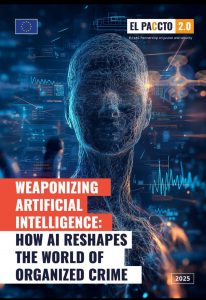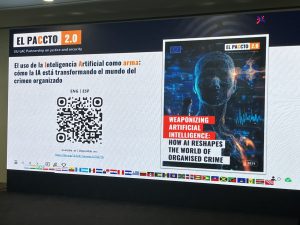EL PACCTO’s Report: Weaponizing Artificial Intelligence. How AI Reshapes the World of Organized Crime officially presented in Rio de Janeiro


This week, during the Second Bi-Regional Conference on AI and Crime organized by EL PACCTO 2.0, the study Weaponizing Artificial Intelligence. How AI Reshapes the World of Organized Crime was presented and discussed among the authors and nearly 120 stakeholders attending this relevant conference in Rio de Janeiro. This report, which I had the honor to coordinate and draft along with three other brilliant experts from Spain (National Police and the Judiciary) and France (the Judiciary) presents the latest typology of trends relating to the use of AI for criminal purposes and in the context of organized crime. The report is divided into five main blocks with a final section highlighting relevant recommendations and a general conclusion.
The first block provides a mapping of the current landscape of attacks enabled and facilitated by AI systems, the current enforcement challenges faced by law enforcement authorities in Europe and Latin America and the Caribbean (LAC) and highlights the challenge of creating concrete legal frameworks based in EL PACCTO’s Model Law on AI and Crime, which was also launched during the Bi-regional Conference in Rio de Janeiro.
The second block provides a detail analysis of the major crimes assisted through the use of AI, and a mapping of some of the most recent crimes committed within the context of organised crime like polymorphic malware, ransomware, phishing, distributed denial of service (DDoS), financial crimes, crypto fraud, stock manipulation, deepfakes and social engineering attacks, autonomous drones, AI controlled weapons, driverless vehicles as weapons, semi-submersible vessels and maritime drones, CSEA material through generative AI. This block also covers other relevant areas currently exploited by organized criminal groups like recruitment and exploitation of young perpetrators, disinformation operations and emerging AI enabled crimes like virtual kidnappings and large scale blackmail pointing out to current real case illustrations and examples, including an analysis of AI assisted hacking tools and major international investigations and cases in Europe, Latin America and the Caribbean that make the report a ‘must read’ document.
The third block contains an analysis of the role of AI agents and AI service providers in the misuse of AI systems for criminal and malicious purposes. This section provides an analysis of the role of AI agents and AI models that can act autonomously with minimal or no human intervention to commit criminal activities highlighting current examples and case studies and explaining how criminals circumvent AI safeguards and develop AI code to automate tasks and facilitate more sophisticated attacks. This section shows that by automating tasks through AI tools, criminal actors can save time, money, reach more targets, and reduce the need for human involvement, making their operations more scalable and harder to detect. This block also provides a brief analysis of the policies of AI providers like OpenAI and Google to report illicit generated content to law enforcement authorities.
The fourth block, addresses the criminal liability of AI systems and highlights one specific case occurred in Belgium and two cases in USA. This section provides an assessment of the response of criminal justice authorities in Europe in the investigation of AI assisted crimes and the challenges concerning the need to reformulate the attribution of criminal responsibility in contexts where AI systems operate autonomously or semi-autonomously, the importance of admissibility of AI generated evidence in national courts and improving international cooperation and strengthening capacity building initiatives at the national level.
Block five refers and explains the importance of EL PACCTO’s new Model Law on Artificial Intelligence and Crime the main purpose of which is to serve as model framework that can assist countries to generate future reforms of substantive and procedural criminal legislation at the national level to counter the use of AI systems for criminal and malicious purposes currently exploited by organized criminal groups operating and targeting victims located in LAC countries. This block contains a section that highlights the importance of fostering cooperation between AI providers and criminal justice authorities and the need to elevate the discussions and fora to involve AI providers more proactively to collaborate with law enforcement authorities in the identification of crimes assisted using their AI based services.
The report contains a section with recommendations for actions highlighting nine relevant key and strategic actions aimed at addressing the challenges discussed in the report for country delegates that are part of EL PACCTO and a conclusion that places a strong emphasis in the implementation of the Regional Model Law on Artificial Intelligence and Crime and the development of public-private cooperation partnerships between criminal justice authorities and AI providers, deployers and companies to tackle AI assisted crimes more effectively.
The report is available in English and Spanish at:
https://zenodo.org/records/17281249
Feel free to share and cite this report and send us your feedback. This report presents relevant cases studies and concrete examples that make it stand out from any other available study or report.